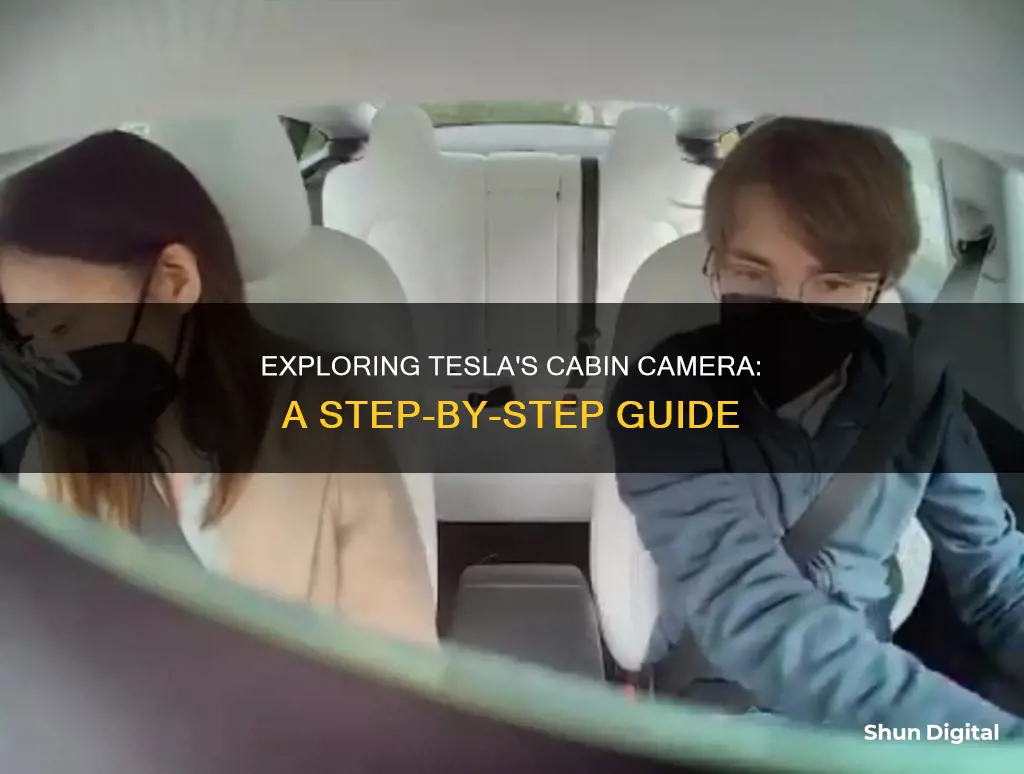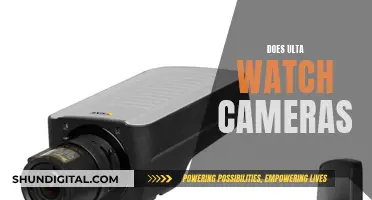
Tesla's cabin camera is located above the rear-view mirror and can determine driver inattentiveness, providing audible alerts to remind drivers to keep their eyes on the road when Autopilot is engaged. Images and videos from the camera do not leave the vehicle or get transmitted to anyone, including Tesla, unless data sharing is enabled. In the case of a safety event, such as a collision, Tesla can receive short video clips to enhance safety features and software. Users can adjust data sharing preferences by going to 'Controls' > 'Software' > 'Data Sharing' > 'Allow Cabin Camera Analytics'. While the cabin camera cannot be viewed while driving, it can be accessed when the vehicle is parked and sentry mode or dog mode is activated.
| Characteristics | Values |
|---|---|
| Location of cabin camera | Above the rear-view mirror |
| Purpose of cabin camera | Determine driver inattentiveness and provide audible alerts to keep eyes on the road when Autopilot is engaged |
| Data transmission | By default, images and video from the camera do not leave the vehicle itself and are not transmitted to anyone, including Tesla, unless you enable data sharing |
| Data transmission when data sharing is enabled | In the occurrence of a serious safety risk or a safety event like a collision, the vehicle can share images and short video clips with Tesla to help develop future safety features and software enhancements |
| Data sharing settings | Controls > Software > Data Sharing > Allow Cabin Camera Analytics |
| Camera lens maintenance | Keep the camera lens clean and free of obstructions. Remove any buildup of dirt or dust by occasionally wiping the camera lens with a clean cloth. Do not use chemical-based or abrasive cleaners |
| Cabin camera access | Owners can view the cabin camera feed from within the vehicle. Owners can also view the cabin camera feed remotely while the vehicle's Sentry Mode or Dog Mode features are activated |
What You'll Learn

The cabin camera is located above the rear-view mirror
The cabin camera in a Tesla vehicle is located above the rear-view mirror. This camera has several important functions, including monitoring driver attentiveness and providing audible alerts to remind the driver to keep their eyes on the road when Autopilot is engaged. This feature helps to improve road safety and reduce the risk of accidents due to driver inattentiveness.
By default, images and video footage captured by the cabin camera remain within the vehicle and are not transmitted externally, including to Tesla, unless data sharing is enabled by the user. This setting can be adjusted by navigating to 'Controls' > 'Software' > 'Data Sharing' > 'Allow Cabin Camera Analytics'. Data sharing is completely optional and users can change their preferences at any time.
It is important to note that Tesla prioritises user privacy. Even when data sharing is enabled, cabin camera images are not linked to the vehicle identification number (VIN) and are solely used to enhance safety features and software improvements. Additionally, the cabin camera does not perform facial recognition or any other form of identity verification.
To ensure optimal performance of the cabin camera, it is essential to keep the camera lens clean and free of obstructions. This can be achieved by occasionally wiping the lens with a clean, soft cloth. However, it is important to avoid using chemical-based or abrasive cleaners as they can damage the surface of the camera lens.
The cabin camera in Tesla vehicles offers valuable functionality for drivers, and understanding its placement and purpose can enhance the overall driving experience and peace of mind.
How to Find the Camera on Your Vizio Smart TV?
You may want to see also

By default, cabin camera data does not leave the vehicle
Tesla vehicles are developed with the highest standards of safety and security in mind. The cabin camera, located above the rear-view mirror, is designed to enhance active safety features and improve the driving experience.
By default, images and video from the cabin camera do not leave the vehicle and are not transmitted to anyone, including Tesla. This means that your privacy is protected, and Tesla cannot view or access this data unless you choose to enable data sharing.
Data sharing can be enabled by adjusting your preferences in the vehicle's settings. To do this, go to 'Controls' > 'Software' > 'Data Sharing' > 'Allow Cabin Camera Analytics'. It is important to note that even with data sharing enabled, your cabin camera data is not associated with your vehicle identification number, ensuring your privacy.
With data sharing enabled, if a safety-critical event occurs, such as a collision, your Tesla vehicle will share short cabin camera video clips with Tesla. This data sharing helps in the development of future safety enhancements and the improvement of features that rely on the cabin camera, such as driver inattentiveness detection and audible alerts.
Additionally, data may also be shared if diagnostics are required for cabin camera functionality. It is important to keep the camera lens clean and free of obstructions to ensure optimal performance.
Skyworth TV: Camera-Equipped or Not?
You may want to see also

Data is only shared with Tesla if data sharing is enabled
Tesla's cabin camera is located above the rear-view mirror in Model 3, Model Y, and 2021 or later Model S and Model X vehicles. The camera can determine driver inattentiveness and provide audible alerts to remind the driver to keep their eyes on the road when Autopilot is engaged.
By default, images and video from the camera do not leave the vehicle itself and are not transmitted to anyone, including Tesla, unless you enable data sharing. This setting can be adjusted by tapping 'Controls' > 'Software' > 'Data Sharing' > 'Allow Cabin Camera Analytics' on the vehicle's touchscreen.
If you choose to enable data sharing, in the event of a serious safety risk or a safety event like a collision, the vehicle can share short video clips with Tesla to help develop future safety features and software enhancements, such as collision avoidance. It is important to note that this data is not linked to your Vehicle Identification Number (VIN) and is used solely to improve the intelligence of features that rely on the cabin camera.
You may change your data sharing settings at any time. Additionally, Tesla does not perform facial recognition or any other method of identity verification with the cabin camera.
TV Cameras at NFL Games: How Many Are There?
You may want to see also

The camera can determine driver inattentiveness and provide audible alerts
The Tesla Model Y, Model 3, Model S (2021 or later), and Model X (2021 or later) are equipped with a cabin camera located above the rear-view mirror. This camera can determine driver inattentiveness and provide audible alerts to remind the driver to keep their eyes on the road when Autopilot is engaged.
The cabin camera uses advanced technology to detect when the driver is not paying attention to the road. For example, it can notice when the driver looks down at their phone, although it may struggle in low-light conditions. The camera does not perform facial recognition or any other method of identity verification.
When the camera detects driver inattentiveness, it will provide an audible alert to remind the driver to keep their eyes on the road. This is particularly important when Autopilot is engaged, as it can help to prevent accidents or incidents caused by driver complacency.
By default, images and video from the cabin camera do not leave the vehicle itself and are not transmitted to anyone, including Tesla, unless the driver chooses to enable data sharing. If data sharing is enabled, and a safety-critical event occurs (such as a collision), the vehicle can share short cabin camera video clips with Tesla to help develop future safety enhancements and improve the intelligence of features that rely on the cabin camera.
It is important to note that the cabin camera data is not associated with the vehicle identification number and can be changed at any time by adjusting data-sharing preferences in the vehicle's settings.
Employee Surveillance: Legal Boundaries in Australia
You may want to see also

You can view the cabin camera feed from within the vehicle
To view the cabin camera feed from within your Tesla vehicle, you need to have received the first update of 2023 (update 2023.2). This update allows you to view the cabin camera directly from inside your vehicle.
To view the live cabin camera feed, navigate to Controls > Service > Camera Preview on your vehicle's touchscreen. Once you turn on the live feed, it will take up the entire right portion of the screen on a Model 3 and Model Y, allowing you to view the feed in detail.
Please note that prior to this update, owners were unable to access the cabin camera feed themselves. The cabin camera was previously only used for driver monitoring while Full Self-Driving or Autopilot was engaged. With the new update, you can now see what the camera can and cannot see when activated, providing peace of mind and awareness of what is being transmitted to a remote viewer.
Additionally, it is important to mention that by default, images and video from the cabin camera do not leave the vehicle itself and are not transmitted to anyone, including Tesla, unless you enable data sharing. If you choose to enable data sharing, in the event of a serious safety incident or collision, short video clips may be shared with Tesla to enhance safety features and software. You can adjust your data sharing preferences by going to Controls > Software > Data Sharing > Allow Cabin Camera Analytics.
The Single Camera Show: How It's Different
You may want to see also
Frequently asked questions
No, they cannot see you while driving. Only when the car is parked and sentry mode is on.
A notification will be displayed on the car's screen.
Yes, you can put tape over the camera. However, this will cause an error with the safety systems.
Yes, you can adjust your data sharing preferences by going to Controls > Software > Data Sharing > Allow Cabin Camera Analytics.
You can view the cabin camera feed by going to Controls > Service > Camera Preview.







